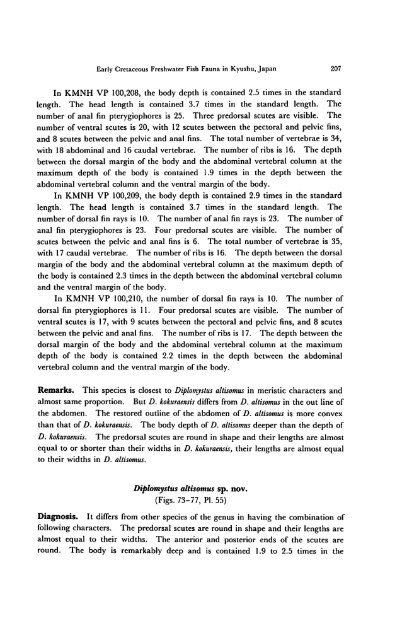Early Cretaceous Freshwater Fish Fauna in Kyushu, Japan
Early Cretaceous Freshwater Fish Fauna in Kyushu, Japan
Early Cretaceous Freshwater Fish Fauna in Kyushu, Japan
You also want an ePaper? Increase the reach of your titles
YUMPU automatically turns print PDFs into web optimized ePapers that Google loves.
<strong>Early</strong> <strong>Cretaceous</strong> <strong>Freshwater</strong> <strong>Fish</strong> <strong>Fauna</strong> <strong>in</strong> <strong>Kyushu</strong>, <strong>Japan</strong> 207<br />
In KMNH VP 100,208, the body depth is conta<strong>in</strong>ed 2.5 times <strong>in</strong> the standard<br />
length. The head length is conta<strong>in</strong>ed 3.7 times <strong>in</strong> the standard length. The<br />
number of anal f<strong>in</strong> pterygiophores is 25. Three predorsal scutes are visible. The<br />
number of ventral scutes is 20, with 12 scutes between the pectoral and pelvic f<strong>in</strong>s,<br />
and 8 scutes between the pelvic and anal f<strong>in</strong>s. The total number of vertebrae is 34,<br />
with 18 abdom<strong>in</strong>al and 16 caudal vertebrae. The number of ribs is 16. The depth<br />
between the dorsal marg<strong>in</strong> of the body and the abdom<strong>in</strong>al vertebral column at the<br />
maximum depth of the body is conta<strong>in</strong>ed 1.9 times <strong>in</strong> the depth between the<br />
abdom<strong>in</strong>al vertebral column and the ventral marg<strong>in</strong> of the body.<br />
In KMNH VP 100,209, the body depth is conta<strong>in</strong>ed 2.9 times <strong>in</strong> the standard<br />
length. The head length is conta<strong>in</strong>ed 3.7 times <strong>in</strong> the standard length. The<br />
number of dorsal f<strong>in</strong> rays is 10. The number of anal f<strong>in</strong> rays is 23. The number of<br />
anal f<strong>in</strong> pterygiophores is 23. Four predorsal scutes are visible. The number of<br />
scutes between the pelvic and anal f<strong>in</strong>s is 6. The total number of vertebrae is 35,<br />
with 17 caudal vertebrae. The number of ribs is 16. The depth between the dorsal<br />
marg<strong>in</strong> of the body and the abdom<strong>in</strong>al vertebral column at the maximum depth of<br />
the body is conta<strong>in</strong>ed 2.3 times <strong>in</strong> the depth between the abdom<strong>in</strong>al vertebral column<br />
and the ventral marg<strong>in</strong> of the body.<br />
In KMNH VP 100,210, the number of dorsal f<strong>in</strong> rays is 10. The number of<br />
dorsal f<strong>in</strong> pterygiophores is 11. Four predorsal scutes are visible. The number of<br />
ventral scutes is 17, with 9 scutes between the pectoral and pelvic f<strong>in</strong>s, and 8 scutes<br />
between the pelvic and anal f<strong>in</strong>s. The number of ribs is 17. The depth between the<br />
dorsal marg<strong>in</strong> of the body and the abdom<strong>in</strong>al vertebral column at the maximum<br />
depth of the body is conta<strong>in</strong>ed 2.2 times <strong>in</strong> the depth between the abdom<strong>in</strong>al<br />
vertebral column and the ventral marg<strong>in</strong> of the body.<br />
Remarks. This species is closest to Diplomystus altisomus <strong>in</strong> meristic characters and<br />
almost same proportion. But D. kokuraensis differs from D. altisomus <strong>in</strong> the out l<strong>in</strong>e of<br />
the abdomen.<br />
The restored outl<strong>in</strong>e of the abdomen of D. altisomus is more convex<br />
than that of D. kokuraensis. The body depth of D. altisomus deeper than the depth of<br />
D. kokuraensis. The predorsal scutes are round <strong>in</strong> shape and their lengths are almost<br />
equal to or shorter than their widths <strong>in</strong> D. kokuraensis, their lengths are almost equal<br />
to their widths <strong>in</strong> D. altisomus.<br />
Diplomystusaltisomus sp. nov.<br />
(Figs. 73-77, PI. 55)<br />
Diagnosis. It differs from other species of the genus <strong>in</strong> hav<strong>in</strong>g the comb<strong>in</strong>ation of<br />
follow<strong>in</strong>g characters. The predorsal scutes are round <strong>in</strong> shape and their lengths are<br />
almost equal to their widths. The anterior and posterior ends of the scutes are<br />
round. The body is remarkably deep and is conta<strong>in</strong>ed 1.9 to 2.5 times <strong>in</strong> the

















